

Table of contents
- Start of season: August/September – October
- mid August
- late August/September
- September October November
- winter season
- Mushroom season between March and July
- March
- April
- May
- June
- Best collection time
- Year-round mushroom season
Instead of buying mushrooms wrapped in plastic from the supermarket, many prefer to collect or grow them yourself. The offer is rich, but not every type of mushroom has mushroom season at the same time. If you are interested in general mushroom picking, you will find an extensive range in autumn. If you are looking for special types of mushrooms, you should know when the best time to mushroom is for which types of mushrooms.
Start of season: August/September – October
When it rains outside after a few days of drought and the sun increasingly loses its strength, numerous types of mushrooms sprout from mid-August. This is where the official mushroom season begins.
mid August
Bovist(Bovista)

- Taste: very fungus
- Likelihood of confusion: with poisonous small, globular potato puffball
- incident: Lawns, parks, meadows, dry lawns
pearl fungus(Amanita rubescens)

- Taste: mild, earthy to slightly bitter
- Likelihood of confusion: with poisonous panther mushroom (Amanita pantherina)
- incident: mainly in deciduous and coniferous forests
- Can only be eaten cooked
late August/September
Numerous types of mushrooms such as meadow, forest and aniseed mushrooms

- Taste: the browner the nuttier
- Likelihood of confusion: with poisonous death cap mushrooms
- incident: compost, forests, meadows, gardens
chestnut boletus(Imleria badia)

- Taste: pleasantly mushroomy
- Likelihood of confusion: with porcini mushrooms, inedible boletus (Tylopilus felleus)
- incident: mainly in coniferous forests with spruce
- Special feature: grows as early as June/July in humid summer
Herbsttrumpet / Totentrumpet(Craterellus cornucopioides)
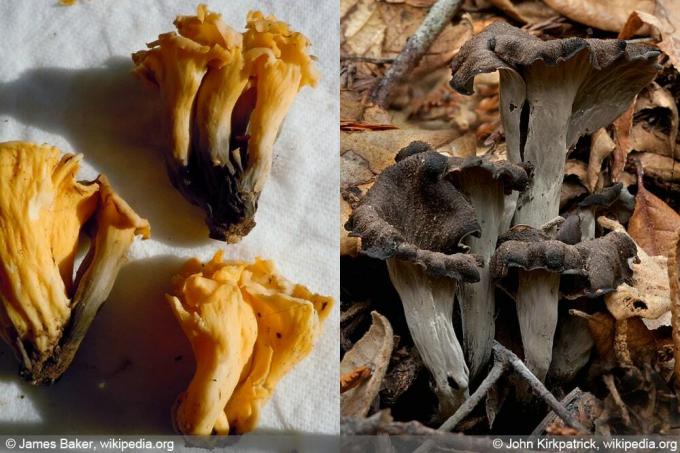
- Taste: strongly aromatic
- Likelihood of confusion: no poisonous "double"
- incident: in clusters in deciduous forests
- Special feature: eaten fresh for many, inedible – great taste when dried
Shaggy Tintling(Coprinus comatus) – family of mushrooms

- Taste: mushroomy, mild, sweetish
- Likelihood of confusion: with other, poisonous Tintlingen
- incident: mostly in parks, on meadows, on forest paths and forest edges as well as in the garden
- Particularities: is considered a health mushroom - raw taste less good
porcini mushrooms(Boletus sect. boletus)

- Taste: mild to intense
- Likelihood of confusion: inedible bile boletus (Tylopilus felleus), chestnut blank (Imleria badia)
- incident: mostly in mixed forest, like with spruce
- Very popular type of mushroom
chanterelles(Cantharellus cibarius)
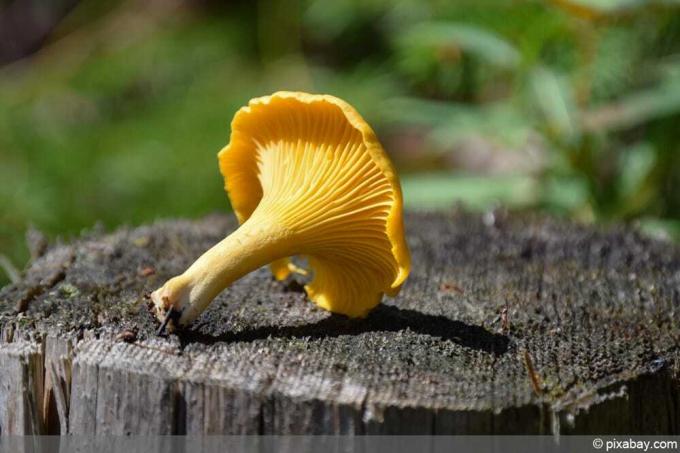
- Taste: mildly fungal, cartilaginous
- Likelihood of confusion: tasteless false chanterelle (Hygrophoropsis aurantiaca)
- incident: in sparse forests with mossy soils
September October November
Smoke / Grey-Leaf Brimstone(Hypholoma capnoides)
- Taste: Mildly mushroomy, spicy, nutty
- Likelihood of confusion: Green-Leaf Brimstone, Brick-Red Brimstone— both highly toxic
- incident: in almost all forests – preferably beech and spruce forests as well as mixed beech-fir forests
Honey fungus / honey fungus(Armillaria)

- Taste: soapy, tart
- Likelihood of confusion: with Sparriger Schuppling (Pholiota squarrosa)
- incident: on living and dead wood
Mutabilis / Common Mutabilis(Kuehneromyces mutabilis)

- Taste: mild, aromatic
- Likelihood of confusion: with poison häuling (Gallerina marginata)
- incident: on dead hardwood, stumps, branches, occasionally on conifers
A NOTICE:
The green mushroom (Tricholoma equestre), which grows at the end of October / beginning of October, used to be a popular edible mushroom. The latest findings have experts warn against consumption, because today it is known that the fungus can cause muscle damage.
winter season
The wintry mushroom season begins at the end of November/beginning of December. If the weather conditions are not immensely icy and long-lasting, there is a good chance of being able to collect various winter mushrooms until around February. These include:
velvet foot(Flammulina velutipes)
- Taste: nutty
- risk of confusion with poisonous poison chief (Gallerina marginata)
- incident: usually near deciduous trees
Oyster Mushroom / Veal Mushroom(Pleurotus ostreatus)
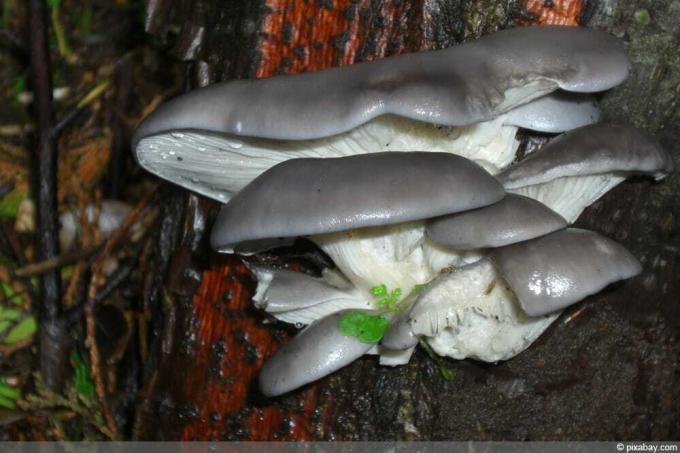
- Taste: nutty
- Likelihood of confusion: with poisonous mussel mushrooms (Panellus serotinus)
- incident: on deadwood and deciduous trees
Coffee-brown fork funnel(Pseudoclitocybe cyathiformis)
- Taste: mild mushroom aroma
- Likelihood of confusion: other non-venomous funnel larvae
- incident: mostly in fir and beech forests, mixed forests, along grassy roadsides
- Delicacy in Greece and Bulgaria
Judas Ear / Chinese Morel(Auricularia auricula-judae)
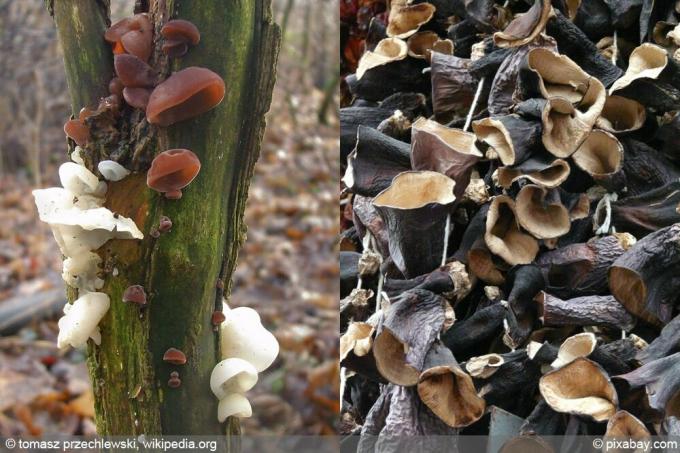
- Taste: slightly nutty
- Likelihood of confusion: with lorel mushroom (Helvella)
- incident: often on juniper trees
Mushroom season between March and July
Early mushrooms are those that grow from March/June. In contrast to the autumn and winter mushrooms, they usually show up with significantly less taste and quality. Early mushrooms include:
March
March snails / snow agaric(Hygrophorus marzuolus)
- Taste: very mild
- Likelihood of confusion: with poisonous brick red crack fungus (Inocybe erubescens, syn. Inocybe patouillardii)
- incident: Mixed forest, fir, spruce
Spruce cone carrots(Strobilurus esculentus)
- Taste: spicy, mushroomy, nutty, mild
- Likelihood of confusion: with pine cone carrots (Strobilurus tenacellus)
- incident: mainly in mixed and coniferous forests on spruce
Pinecone turnips(Strobilurus tenacellus)
- Taste: from spicy-mild to bitter and pungent
- Likelihood of confusion: with spruce cone carrots
- incident: mainly in mixed and coniferous forests on pines
April
Blister mugling(Peziza vesiculosa)
- Taste: very mild, hardly any taste of its own
- Likelihood of confusion: with inedible False Bubble Mugling (Peziza pseudoversiculosa syn. Peziza Amplissima)
- incident: mostly on dung, in mixed and deciduous forests
May

- Occasionally already porcini mushrooms (especially in the north and south) – (see under “From the end of August/September”)
- Occasionally already chanterelles (especially in the north) – (see under “From the end of August/September”)
June
Parasol / Common Parasol(Macrolepiota procera)

- Taste: pleasantly nutty, mild
- Likelihood of confusion: Saffron Giant Parakeet
- incident: in forests, on grassy areas, along paths and on calcareous soils
Best collection time
In addition to the mushroom season in which the different types of mushrooms grow, it also plays a role on which days and at what time of the day mushrooms are collected. Basically, slightly damp weather promotes growth, with warm and changeable weather providing an ideal time. Too dry conditions cause mushrooms to dry up quickly. Conditions that are too humid provoke rot and the formation of maggots. The best picking time for looking for mushrooms is therefore early morning in said months, when weather has preceded as described.
Tip:
Don't pick mushrooms that grow near busy roads or industries. They are very receptive to pollutants in the air. This changes the taste and can have a negative effect on health.
Year-round mushroom season
Depending on the weather conditions, mushrooms grow all year round. However, summer and autumn are the main seasons for most types of mushrooms. However, some types of mushrooms can be cultivated all year round in a well-insulated cellar. This is especially possible with mushrooms.
 Home editorial office
Home editorial office
Learn more about mushrooms - types and varieties

Identify white fungi in the garden
White or whitish mushrooms can appear in various places in the garden. This article is intended to help identify them more easily. However, since fungi are very changeable, a certain amount of caution is always advisable.

Collect, prepare and dry porcini mushrooms | All information about the porcini mushroom
Porcini mushroom hunt made easy! Here you can find out where and when it is best to search for the popular edible mushroom. In addition, we give you helpful tips for further processing, preservation and storage!

Grow truffles yourself – this is how you grow the mushroom specialty
Truffles were thought to be extinct in Germany for a long time, but they are actually still wild. They are protected, so they may not be collected. On the other hand, cultivation and harvesting are permitted on one's own land - not that difficult.
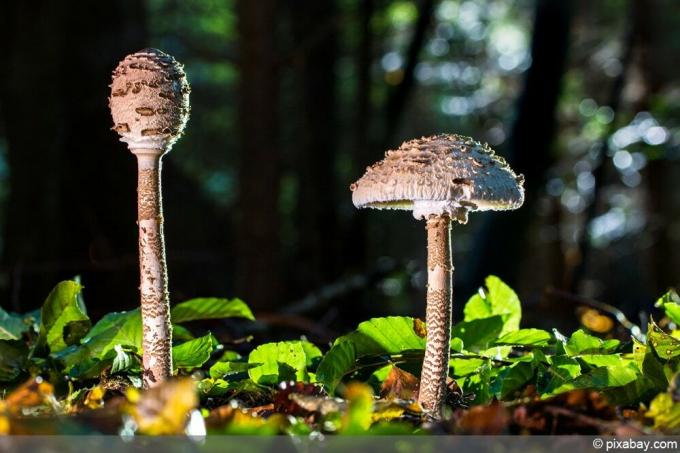
Parasol mushroom - is it poisonous? How to recognize him correctly
In the article you will learn why the parasol mushroom is definitely not poisonous, but was voted "edible mushroom of the year 2017" for good reason.

Popular Forest Mushrooms – Recognizing Edible Mushrooms + Photos
Collecting forest mushrooms is very popular. When preparing in the kitchen, many recipes invite you to try out different dishes. For many mushroom pickers, staying in the great outdoors is another important reason for this beautiful hobby. Wild mushrooms are tasty and safe if you know your stuff. It is important that you can confidently distinguish an edible mushroom from a toadstool.

Ball Tree: Care from A – Z | These 9 varieties are suitable for ball trees
Ball trees adorn many a garden, front yard and entrance area. They require little space. Their trunk thickens with age, but its height remains the same. The spherical crown is easy to trim. Nevertheless, they offer everything that makes a tree.
